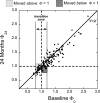Theoretical implications of the biomechanical fracture threshold
- PMID: 18410232
- PMCID: PMC2684155
- DOI: 10.1359/jbmr.080406
Theoretical implications of the biomechanical fracture threshold
Abstract
Because of the dichotomous nature of a bone fracture, when Phi, the ratio of the applied impact force to the bone strength, is greater than a critical value--the biomechanical fracture threshold--fracture should occur. We sought to elucidate the conceptual implications of this biomechanical fracture threshold with application to hip fracture. We used data from the PaTH study, a 2-yr clinical trial in postmenopausal women treated with alendronate, PTH, or their combination. Outcomes included the force applied to the hip in a sideways fall as estimated from subject height and weight; femoral strength as determined by QCT-based finite element analysis; the load-to-strength ratio Phi; and total hip areal BMD from DXA. Results indicated that those with "very low" femoral strength (<2000 N) invariably had load-to-strength ratio Phi values well above the theoretical biomechanical fracture threshold (Phi = 1), but those with "moderately low" femoral strength (2000-4000 N) displayed Phi values both above and below the theoretical biomechanical fracture threshold. This finding implies that the risk of a hip fracture can be high in those with only moderately low BMD because femoral strength can be low relative to fall impact forces. The observed weak correlation between areal BMD and the load-to-strength ratio Phi (r2 = 0.14) suggests that consideration of the biomechanical fracture threshold may improve fracture risk assessment, particularly for those in the osteopenic range. Regarding treatment effects, only those subjects having load-to-strength ratio Phi values within a relatively narrow "transition zone" of +/- 20% of the assumed biomechanical fracture threshold at baseline were predicted to change fracture status during the trial. In theory, outcomes of fracture trials may be dominated by the responses of those within the "transition zone" at baseline, and treatment benefits in terms of fracture efficacy may depend the patient's baseline status with respect to the biomechanical fracture threshold. We conclude that consideration of the theoretical implications of the biomechanical fracture threshold may lead to new insights and advances in the assessment and treatment of osteoporosis.
Figures




References
-
- Hayes WC, Piazza SJ, Zysset PK. Biomechanics of fracture risk prediction of the hip and spine by quantitative computed tomography. Radiol Clin North Am. 1991;29:1–18. - PubMed
-
- Myers ER, Wilson SE. Biomechanics of osteoporosis and vertebral fracture. Spine. 1997;22:25S–31S. - PubMed
-
- Bouxsein M. Biomechanics of Age-Related Fractures. In: Marcus R, Feldman D, Kelsey J, editors. Osteoporosis. 2nd ed. San Diego, CA, USA: Academic Press; 2001. pp. 509–534.
-
- Delmas PD, Seeman E. Changes in bone mineral density explain little of the reduction in vertebral or nonvertebral fracture risk with anti-resorptive therapy. Bone. 2004;34:599–604. - PubMed
-
- Cummings SR, Karpf DB, Harris F, Genant HK, Ensrud K, LaCroix AZ, Black DM. Improvement in spine bone density and reduction in risk of vertebral fractures during treatment with antiresorptive drugs. Am J Med. 2002;112:281–289. - PubMed
Publication types
MeSH terms
Grants and funding
LinkOut - more resources
Full Text Sources
Medical

